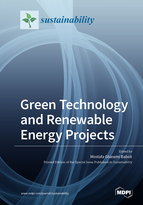Green Technology and Renewable Energy Projects
A special issue of Sustainability (ISSN 2071-1050). This special issue belongs to the section "Sustainable Engineering and Science".
Deadline for manuscript submissions: closed (31 March 2022) | Viewed by 18492
Special Issue Editor
Interests: waste treatment; desalination; microbial fuel cell; polymeric membrane; renewable energy
Special Issues, Collections and Topics in MDPI journals
Special Issue Information
Dear Colleagues,
At present, with the rise in environmental problems around the world, such as global warming and drought, interest in green technologies has increased. Energy is the most important issue of the green technologies. Conventional sources of energy are running out rapidly, and this is one of the main concerns of all governments that need to find, utilize, and provide other sources of energy. Renewable energy is one type of energy source which does not pollute the environment and can also be reproduced. The concern of this Special Issue is to identify new research, innovations, and activities on green technology and renewable energy projects. Research on the impact of green technology and renewable energy, on societies, viability, as well as economic analysis compared to conventional technologies and energy are welcomed. Further, the Special Issue welcomes research on the effect of green technology and renewable energy at different parts of the world and the relation of some advanced technologies such as nanotech, biotech, and so on with green technology and renewable energy, and how effective they can be in solving the problems of the world in the new era.
Assoc. Prof. Dr. Mostafa Ghasemi Baboli
Guest Editor
Manuscript Submission Information
Manuscripts should be submitted online at www.mdpi.com by registering and logging in to this website. Once you are registered, click here to go to the submission form. Manuscripts can be submitted until the deadline. All submissions that pass pre-check are peer-reviewed. Accepted papers will be published continuously in the journal (as soon as accepted) and will be listed together on the special issue website. Research articles, review articles as well as short communications are invited. For planned papers, a title and short abstract (about 100 words) can be sent to the Editorial Office for announcement on this website.
Submitted manuscripts should not have been published previously, nor be under consideration for publication elsewhere (except conference proceedings papers). All manuscripts are thoroughly refereed through a single-blind peer-review process. A guide for authors and other relevant information for submission of manuscripts is available on the Instructions for Authors page. Sustainability is an international peer-reviewed open access semimonthly journal published by MDPI.
Please visit the Instructions for Authors page before submitting a manuscript. The Article Processing Charge (APC) for publication in this open access journal is 2400 CHF (Swiss Francs). Submitted papers should be well formatted and use good English. Authors may use MDPI's English editing service prior to publication or during author revisions.
Keywords
- renewable and nonrenewable energy
- green technology
- environmental protection
- economic viability
- fuel
- social impact
- global warming






